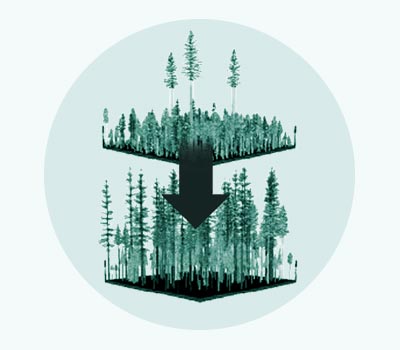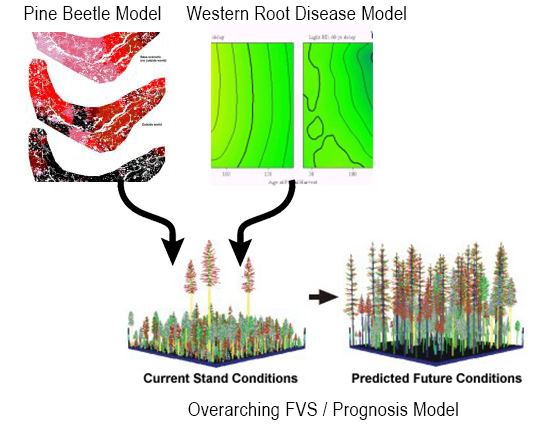Forest Vegetation Simulator
The Forest Vegetation Simulator (FVS; also known as Prognosis) is an individual-tree, distance-independent forest stand projection model. The model simulates the growth and mortality of a sample of a stand’s trees, using characteristics such as species, diameter, height, crown length and relative size.
 Key outputs are produced at the individual tree and stand level; including volume, density, species, diameter, height, annual increment, and crown length. Because of its internal structure, one of its great strengths is the ability to simulate complex stands composed of many species and many ages.
Key outputs are produced at the individual tree and stand level; including volume, density, species, diameter, height, annual increment, and crown length. Because of its internal structure, one of its great strengths is the ability to simulate complex stands composed of many species and many ages.
FVS is a powerful tool for forest management. In addition to its core growth and yield capability, it includes a powerful language that lets users define rules to schedule and simulate activities at the stand level. Users can define and implement almost any type of management system, including planting and regeneration, pruning, thinning from above or below, thinning by diameter range, and thinning with or without species retention preferences. These activities can occur at specific years, intervals, or when user-defined stand conditions are met. Additionally, a number of forest pest extensions have been developed and linked to the core growth model.
FVS is used widely in the USDA Forest Service (USFS) and has been parameterised for the IDF (Interior Douglas-fir), ICH (Interior Cedar Hemlock), SBS (Sub-boreal Spruce) and SBPS (Sub Boreal Pine Spruce) zones of British Columbia. The Ontario Ministry of Natural Resources has also begun development of a variant for southern Ontario.
Over 20 regional variants exist in the US, each parameterised for the growing conditions and important tree species of the different geographic regions. Interfaces also exist to help users import inventory data (or start from bare ground), perform model runs and display and support analysis of model projections.
ESSA has worked with FVS for over twenty years, providing a variety of services:
- Development and support of the Fire and Fuels extension. ESSA developed several models through a process involving interdisciplinary workshops, the creation of prototype models and model documentation, examination of model behaviour, followed by further testing, refinement, and preparation of training materials.
- Calibration of new variants: ESSA is working with the BC Ministry of Forests, the University of British Columbia, and the Ontario Ministry of Natural Resources to help calibrate FVS for forests in parts of BC and Ontario.
- Interface development and support: ESSA maintains and develops the Canadian interface to FVS/Prognosis.
- Custom simulation runs: Members of ESSA’s Forestry Team have performed many thousands of FVS runs involving numerous variants, pest extensions, and management objectives.
Keywords & Themes: Terrestrial resources / Fire / Disaster risk reduction / Hazard assessment / State transition models / Forest management / Data visualization
FVS-BC and FVS-ON are freely available through the open-fvs project hosted by GitHub. The programs can be compiled with tools described in the project wiki. For convenience recent versions are provided here, built as 64-bit executables for Windows using the free R-tools build system
Latest version:
| File | Version | RV |
|---|---|---|
| FVSbc.exe | FS2022.4 | 20221118 |
| FVSbc.dll | FS2022.4 | 20221118 |
| FVSon.exe | 20211231 | 20221118 |
| FVSon.dll | 20211231 | 20221118 |
Earlier versions of the SimProg system have been retired and are replaced by the FVSonline R package. SVS has also been retired and replaced by visualization tools in FVSonline. Please email the contact below for more information on FVSonline.
Key Contacts
Don Robinson
Senior Systems Ecologist
Please email us at [email protected] to inquire about our support services.
To stay up to date on FVS developments, consider subscribing to our FVS mailing list.
Your email will not be shared. ESSA will only send emails relevant to the BC and Ontario variants of the FVS model and you can unsubscribe at any time.

